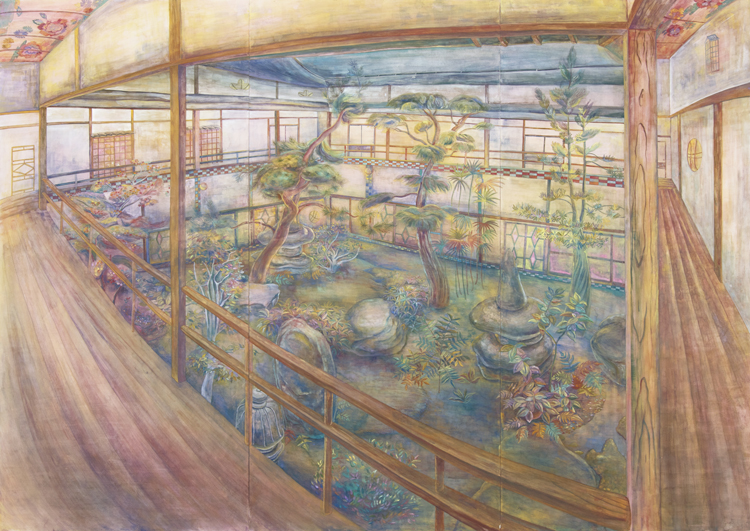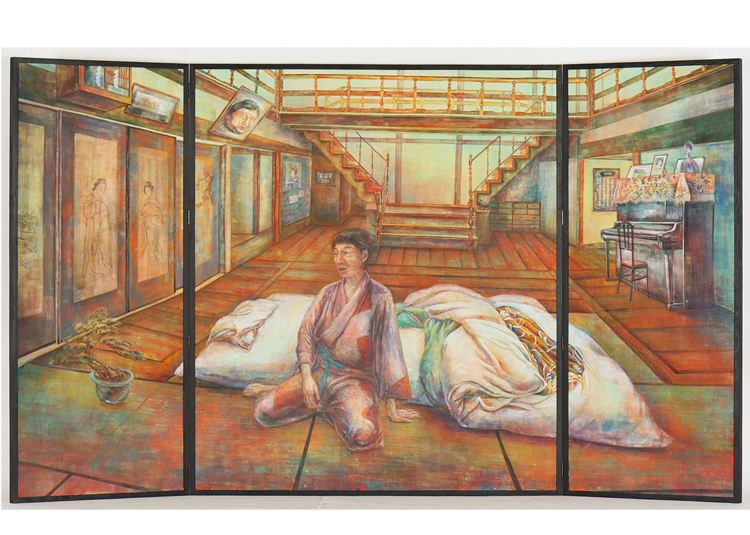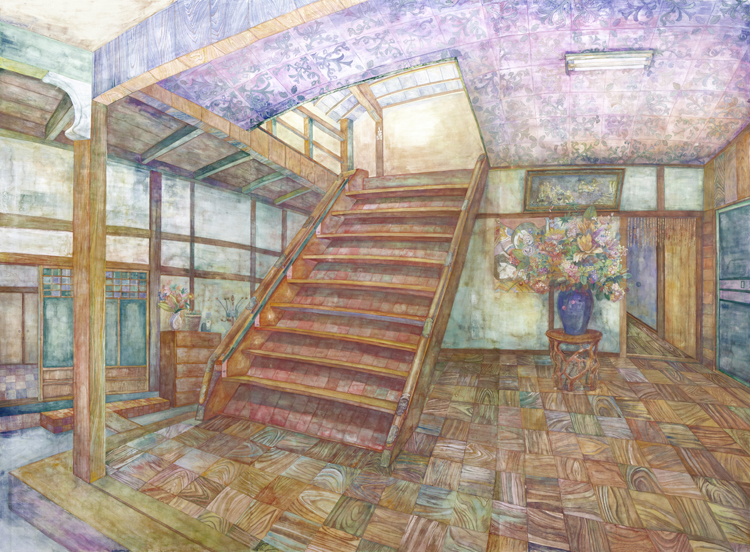椎名 絢 SHIINA Aya

《宿・中庭》 2015年 麻紙、岩絵具、水干絵具、膠 200×284cm
Inn‐Courtyard, 2015, Linen paper, Ⅿineral pigments, Dyed mud pigments, Glue 200×284cm
椎名 絢
SHIINA Aya
1979年、茨城県生まれ 東京に在住、活動。
椎名絢は日本画の技法によって、湿った日本の風景が描きたいのだという。彼女が主題とするのは、かなり寂れてくたびれた地方の温泉旅館の畳の部屋や、そこに佇む、やはり少しくたびれた感じの中年男女であったりする。少し前の日本映画を見るような、白黒の諧調と陰影が美しい小津安二郎ではなく、名もなく忘れられる総天然色時代につくられた大衆映画の味わいがある。それを古臭くいとわしいと感じるか、レトロで素敵と感じるかは人に寄るだろうが、間違いなく椎名はそうした湿り気のある日本の風土が好きらしいのである。
《宿・中庭》はそうした「旅館シリーズ」とでも名付けたい一連の作品のひとつで、作者が一番気に入っている絵だという。ここもかろうじて営業を続けている古い旅館だが、その中庭に庭石や石灯籠、曲がった枝ぶりの松やいくつかの庭木が雑然と植えられていて、それを二階の部屋の周囲に回廊のように廻らせた廊下から見下ろした風景である。広角レンズのカメラで撮ったように、廊下の桟はカーブを描いて歪んで見え、この2階建ての旅館の空間を迷宮のようにも見せている。向かいの回廊の桟の紅白の市松模様や、左上の廊下の天井に描かれた花模様、1階廊下のダイヤ模様のガラス障子など、細部には艶めかしい装飾があり、かつては色街の遊郭であったことをうかがわせる。真ん中で旺盛に茂る植物たちも、何やらなまめいてくねっているようにも見える。(中略)
北澤憲昭⋆の言うように、温泉地のさびれた旅館やストリップが「汚穢の感覚に満ちている」とは過剰な物言いにも思えるし、椎名の使う色まで「画面を染め上げる濁った色づかい」と言うのには同意できないが、わたしたちが通常目にする日本画とは美しく平滑で清明な雰囲気をまとったものが多いことは確かだろう。それに対して椎名は、敢えて「穢い」ものを描いて、日本画の美意識を蹂躙しようとしているのだろうか。(⋆北澤憲昭 椎名絢個展「熱海」案内状、ギャラリーナユタ、2017年 )
爽やかな笑顔の作者に会うと、そんな考えはたちどころに霧散するだろう。椎名の画面の色彩は濁っているのではなく、多色を背後に秘めたまま漂白されたような重層感があり、むしろレトロモダーンな懐かしさを醸し出す。大学の生物学科を卒業して社会人として6年間働いてから、もともと好きだった絵の世界に飛び込んだ椎名絢は、むしろ理科系の視点で、自分と正反対の日本の湿潤な風土を愛して観察しているのではなかろうか。《宿・中庭》は、そんな椎名の理想の風景であるように思える。年齢的にはそれほど若手とは言えないが、画家としての出発の遅かった彼女は、まだ歩み始めたばかりである。にもかかわらず、すでに独特の自分の世界を確立している。
小勝禮子「推薦文」より一部抜粋、「第7回東山魁夷記念日経日本画大賞展」図録、日本経済新聞社、2018年
Born in IBARAKI, Japan, 1979. Lives and works in Tokyo, Japan.
According to Shiina Aya, she aims to depict landscapes that convey the sense of moisture that is unique to Japan, through using the techniques of Japanese-style painting. The themes of her paintings include a tatami room at a hot-spring inn that is located in some desolate, dilapidated rural area, and the somewhat weary-looking middle-aged man and woman who are in that desolate environment. Her works suggest the essence of the nameless and forgotten movies made for the masses, which were produced during the Technicolor period in the first half of the 20th century. That is, they are unlike Ozu Yasujiro’s films that reveal beautiful gradations and nuances in black and white, which we used to see in Japanese films in the not so distant past. Whether such an expression as Shiina’s is perceived as outdated and distasteful, or as admirable and retro, depends on individual taste, but she is unquestionably attracted to that cultural climate of Japan that inheres a unique and almost nostalgic sense of moisture.
Her painting Inn-Courtyard, which is one of the works in a series that I am tempted to give the title “Inn Series,” is said to be the artist’s favorite work. Similar to her other paintings, the setting of this work is an old inn that appears to be barely staying in business. The work portrays an inner courtyard that is composed of garden rocks, a stone lantern, and disorderly planted garden trees, including a pine tree with curved branches. This cloister garden is seen from the second-floor corridor that encircles the circumference along the entrances of the rooms. As if it was photographed with a wide-angle lens, the wooden handrail in the corridor is curved and looks warped, so that the space of the two-floor inn also resembles a labyrinth. One can also find alluring decorations in the details of the painting, such as the red-and-white checkered pattern along the baseboard on the other side of the corridor; the flower pattern painted on the ceiling in the left corner of the corridor; and the diamond pattern on the glass sliding doors along the first-floor corridor. These details imply that the inn was a brothel in a red-light district. In addition, the luxuriant plants in the center of the garden can be seen as something alluring and curvy. […]
As has been indicated by art critic Kitazawa Noriaki,* it is true that many Japanese-style paintings we normally view are clad in a smooth and lucid ambience. However, I felt that his view on Shiina’s works, which referred to the images of a run-down inn and a strip club in a hot-spring district as “filled with a sense of impurity,” was an excessive way of describing it. I also disagreed with his view that went so far as to say that even the colors she used were “murky colors that dye the entire surface.” It might be that Shiina deliberately depicted “foul” images in opposition to the typical Japanese-style painting, with the aim of trampling on the conventional aesthetic sense inherent in Japanese-style painting.
(* KITAZAWA Noriaki, excerpt from Shiina Aya’s exhibition Atami, invitation card, Gallery Nayuta, 2017.)
Such views on her works will instantly vanish the moment one meets the refreshing smile on the artist’s face. The colors in her works are not murky; rather, they generate a retro-modern sense of nostalgia. They convey a multilayered feeling that results from their being decolorized, while also concealing the multi colors applied on the background just as they are. After graduating from the biology department of a university and then working for six years, Shiina Aya dived into the world of painting that she had always liked. Thus, based on her scientific perspective, she seems to be loving and observing the unique cultural climate of Japan that senses the moisture within things, which is the complete opposite of her own nature. To my eyes, Inn-Courtyard holds Shiina’s ideal scenery that fulfills her artistic aims. She is not a young painter age-wise, but since she was a late starter, her career has just begun. Nevertheless, Shiina has indeed already established her own unique world.
KOKATSU Reiko, excerpt from recommendation essay in the 7th Higashiyama Kaii Memorial Nikkei Nihonga Award (Exh.Cat.), Nihon Keizai Shimbunsha, 2018. (Translated by NANPEI Taeko)
更新された最新の情報は、作家のウェブサイトをご覧ください。
Please refer to the artist’s website for new updates.

《女とふとん》 2013年 麻紙、岩絵具、膠 220×360cm
Woman and Futon , 2013, Linen paper, Ⅿineral pigments, Glue 220×360cm

《ママの部屋》2015年 麻紙、岩絵具、水干絵具、膠 162×162cm
Ⅿama’s Room , 2015, Linen paper, Ⅿineral pigments, Dyed mud pigments, glue , 162×162cm

《宿・階段》 2019年 麻紙、岩絵具、水干絵具、膠 200×300cm
Inn‐Stairs , 2019, Linen paper, Ⅿineral pigments, Dyed mud pigments, Glue , 200×300cm

